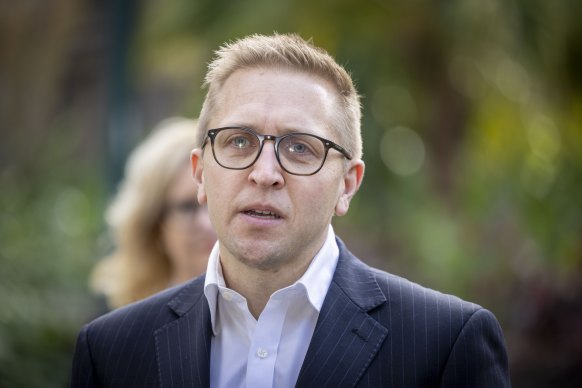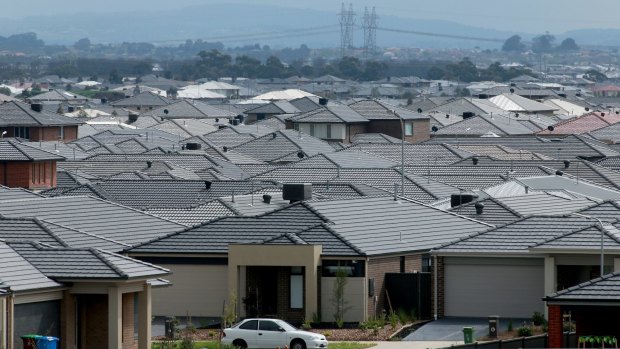This was published 2 years ago
‘There’s a lot at stake’: Push to open up Melbourne’s suburbs to townhouses, apartments
A radical plan to overhaul the tax system for housing, open up Melbourne’s middle suburbs and stop rampant population growth on the city’s outer fringe has been proposed by Victoria’s peak infrastructure body.
In a major new report, Infrastructure Victoria has called for fast-tracked planning approvals for townhouses, relaxed zoning to permit more low-rise apartments and the abolishment of stamp duty and first-home-buyers subsidies to increase housing options and affordability.

Goce Damjanoski with three-year-old son Luka in Kalkallo, in Melbourne’s outer north.Credit: Jason South
The agency’s report, released on Tuesday, says 1.3 million new homes need to be built in Melbourne to meet the projections that the city’s population will swell from 5 million people to more than 8 million over the next 30 years.
But there will be mounting financial and social costs if that growth remains concentrated in the city’s outer-fringe “greenfield” areas, where tracts of farmland have been carved up for detached houses.
Half a million people have moved to seven of Melbourne’s greenfield areas – the municipalities of Cardinia, Casey, Hume, Melton, Whittlesea, Wyndham and Mitchell – over the past decade, accounting for half of Victoria’s total population growth.
Infrastructure Victoria chief executive Jonathan Spear said the agency’s research found one in four people would trade a detached greenfield house for a quality townhouse or three-bedroom apartment in an established area if they were the same price.
“A lot of people are living in growth areas and some of them have told us they’re dissatisfied by the quality and pace at which infrastructure is being delivered to them,” Spear said.
“Added to that, we’re looking at roughly a million people coming to Melbourne each decade over the next three decades. So there’s a lot at stake here in terms of the quality of life of Victorians now and into the future.”
Spear said it was up to four times more expensive to build roads, schools, public transport infrastructure and other essentials in greenfield areas than to provide those services in existing suburbs.
Kalkallo, near Craigieburn on Melbourne’s northern fringe, has become a poster suburb for what can go wrong when infrastructure doesn’t keep up with population growth in greenfield areas.
Goce Damjanoski and his wife bought their first home there, 31 kilometres from the CBD, seven years ago because it was one of the few places they could find a detached three-bedroom home for less than $450,000. They have since had two children – son Luka, now 3, and six-week-old daughter Mila.
But Kalkallo’s population boomed from around 100 in 2016 to 5600 in 2021. Now residents sit in gridlocked traffic for up to 1½ hours every morning while they crawl to the suburb’s single-lane exit onto Donnybrook Road.
“People realise when they’re coming to these areas there’s a trade-off. We were willing to trade off a bit of purchase price for that additional travel, but the point comes – what’s unacceptable?” Damjanoski said.
“We’ve discussed if it’s better to move closer to an inner-urban area … [but] it always comes down to cost – we’d need to sacrifice a fair bit to make that happen.”
Infrastructure Victoria questioned more than 6000 people in Melbourne, Geelong and Ballarat about what influenced them to move to their suburb. It found a clear preference (68 per cent) for a traditional detached family house, with three or more bedrooms and a garage, located close to family and friends.
Greenfield and outer-suburban areas are the only places in Melbourne where moderate income households (those who earn $88,000 to $132,020) can afford that quintessential Australian home (costing $780,000 on average), the report says, and people moving there are willing to trade off location and amenity for price.
But it also found that if apartments and townhouses dropped 10 per cent in price and greenfield houses increased by 10 per cent, there would be a 17 per cent swing in demand towards the smaller homes in established suburbs.
“What we can do is somewhat slow down the growth of these greenfield areas, which will help the
government to meet the infrastructure needs that we have,” Spear said.
Infrastructure Victoria says housing growth could be rebalanced with a suite of reforms, including implementing a townhouse code to make it easier for property owners to bypass red tape, and setting incentives for local governments on meeting numbers of new homes.
The state government could also impose new design standards to make apartments more appealing for families with children, the infrastructure body says, remove minimum parking requirements to reduce apartment prices, and rezone more suburbs to allow for apartments up to four storeys high.
Only 1 per cent of middle suburbs allow four-storey apartments, which “hinders housing diversity and curbs the supply of new homes in good locations”, the report says.
Developers should also pay for more of the cost of building new infrastructure in greenfield areas, as current contribution schemes collect only 15 per cent of that expense.

Matthew Kandelaars, from the Urban Development Institute of Australia, says governments need to discuss suitable levels of housing density.Credit: Wayne Taylor
The report also recommends abolishing stamp duties and the first-home-owner grant, which distort purchasing decisions.
Matthew Kandelaars, the Victorian chief executive of industry lobby group Urban Development Institute of Australia, said the biggest obstacle to increasing medium-density housing was that those projects often faced community objections that ended in long and expensive civil court proceedings.
“State and local government … need to be part of the conversation about changing public perceptions about appropriate density through Melbourne suburbs – they cannot leave that conversation to the development industry alone,” Kandelaars said.
But Ratepayers Victoria vice president Dean Hurlston said housing targets, fast-tracked townhouse approvals and rezoning risked overriding communities’ control over what happens in their neighbourhood.

The urban sprawl in Cranbourne, in Melbourne’s south-east.Credit: Wayne Taylor
“We are worried about anything that can limit the natural rights of communities to object,” Hurlston said.
A state government spokesman said Infrastructure Victoria’s report reinforced the importance of the Suburban Rail Loop project, which would trigger urban redevelopment along the new major underground rail line.
“We need to deliver more housing and more jobs in areas that are well served by public transport,” the spokesman said.
But Infrastructure Victoria’s report says the rail loop and other urban renewal projects would not be enough to deliver the homes in established suburbs that Melbourne’s growing population requires.
The 12 precincts planned along the eastern and northern sections of the Suburban Rail Loop are expected to accommodate about 139,500 new households by 2056 out of 932,000 new homes needed in established suburbs.
The Morning Edition newsletter is our guide to the day’s most important and interesting stories, analysis and insights. Sign up here.